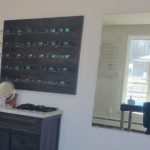
Dr. Sampalis’s optical. Dr. Sampalis carefully tracks per-patient revenue, insurance revenue and new versus established patients to make sure the practice is continuing to increase profitability.
By Maria Sampalis, OD
Sept. 21, 2022
There are many key performance indicators (KPIs) you can track. In my practice, there are three big ones that enabled me to increase the profitability of patient visits and stoke annual practice growth.
Per-Patient Revenue
This KPI can be broken down to eyeglass sales, contact-lens sales, specialty contact-lens fits and additional sales in your practice. Breaking patient encounters down further into medical versus routine visits is important as well.
To calculate your revenue per encounter, you take your gross income divide it by the number of patient encounters. I do this for patients visiting for yearly exams and purchases, however I do not factor in those visiting for follow-up exams. I compare the numbers we arrive at with industry averages and the corresponding number for the previous month and for the same time the previous year.
The average revenue per-patient in the optical industry is $300. We increased it to around $375 in our office. To do this, we make sure every exam slot is booked efficiently to ensure we are making the most of our time. We allot 10 minutes for medical eyecare exams, such as for monitoring of glaucoma patients, and 15 minutes per comprehensive eye exam. I also make sure that my support staff is taking care of the collection of data, so that I can concentrate heavily on the interpretation of data and discussion with patients in the exam room.
When our per-patient revenue was only at the industry average of $300, we looked at it and found two primary reasons that it was lower than it should have been: low-reimbursing vision plans and patients who chose not to buy new glasses.
I see 3,000 patients per year. Increasing the revenue generated in each of those encounters by $75 means that I have generated an additional $225,000 annually.
Insurance Revenue
I added up the patient volume for each plan I accepted and then looked at the revenue that was generated from patients using each plan in our office.
I realized that not all the plans we accepted were profitable enough for us to keep accepting. If almost all your patients are visiting you for routine eyecare, and almost all are using vision plans to pay for their visits, your average reimbursement is only going to be around $80 per visit. Some insurance plans may reimburse at even lower rates.
We used to accept four vision plans. After we looked at the reimbursement levels for these plans, we decided to drop two of them.
In addition, we made a concerted effort to add more medical visits, by expanding medical eyecare, focusing on providing comprehensive glaucoma care and diabetic eyecare, for example. We also have substantially grown our dry eye services, which often are paid for out-of-pocket by patients.
Other Articles to Explore
We have an older patient base, so a medical eyecare focus was easier for us to achieve than it may be for other practices. As these visits require use of medical insurance, versus vision insurance, the reimbursements are higher. Where the average vision plan only reimburses at $80 per comprehensive exam, the average medical eyecare visit in my office reimburses at around $200.
New Vs. Established Patients
I like to know we are growing, but I also want to ensure I am keeping my established patient base happy. I make sure I am doing that by calculating the number of returning patients annually. It costs more to get new patients than to retain your existing ones. So, I focus on maximizing profitability from my existing patients while, at the same time, working to attract new patients through targeted marketing. I set an annual goal to add 10 percent new patients, which we usually achieve.
To increase patient loyalty, I take more time for one-on-one conversations in the exam room with my patients. I don’t use scribes, which seems to have helped me solidify my relationships with patients. When it’s just me and the patient in the exam room, I find that the patient opens up more readily about their vision and eye health needs, often talking to me in-depth about their personal and work-life needs. I then am able to better determine the products and services I can provide them with to both help them and grow our profitability.
The time I take with my patients has resulted in a patient retention rate of around 90 percent, meaning 90 percent of patients who visit our practice have previously received care from us. Patients will return if they feel you truly care about their needs and preferences, and are able to provide those things to them.
 Maria Sampalis, OD, is the owner of Sampalis Eye Care in Warwick R.I. and sublease at Warby Parker. She is also the founder of Corporate Optometry on Facebook. Dr. Sampalis is also founder of the job site, corporateoptometrycareers.com. She is available for practice management consulting. To contact: msampalis@hotmail.com
Maria Sampalis, OD, is the owner of Sampalis Eye Care in Warwick R.I. and sublease at Warby Parker. She is also the founder of Corporate Optometry on Facebook. Dr. Sampalis is also founder of the job site, corporateoptometrycareers.com. She is available for practice management consulting. To contact: msampalis@hotmail.com

























